Day 12: Roman Around Edinburgh!
Main Page > 2023 Roman da North in Planes, Trains, and Automobiles ! >
The Boys woke up refreshed and elated that they had roamed, the entire northern border of the Roman Empire, so since they had an extra day, they decided to rome the iconic city of Edinburgh!
An a Foine Mornin' it tis in the Heart of the Scots! Edinburgh!!!
Edinburgh is certainly a magical place, nestled in the Firth of Forth on the blustery North Sea, it is always windy, wet, and cold, but so dogone fresh and beautiful, especially on a cold, wet morn! Mike and Bone walked out into the quintessential Edinburgh morning heading for the heart of the whole dang town, the Royal Mile!
Ducking the Duke of Wellington in Downtown Edinburgh!
From their hotel, Mike and Bone had to walk down the Prince Street just below the upper city where the Royal Mile resides the regal monument to Sir Walter Scott! Sir Scott was a very famous Scottish novelist, poet and historian. Many of his works remain classics of European and Scottish literature, notably the novels Ivanhoe (1819), Rob Roy (1817), Waverley (1814), Old Mortality (1816), The Heart of Mid-Lothian (1818), and The Bride of Lammermoor (1819), along with the narrative poems Marmion (1808) and The Lady of the Lake (1810). As an advocate, judge, and legal administrator by profession, he combined writing and editing with his daily work as Clerk of Session and Sheriff-Depute of Selkirkshire. He had a major impact on European and American literature, so on his death the grand old City built this very cool shrine on Prince Street that Mike and Bone had was checking out.
Great Scott ! Mike and Bone, @ the Scott Monument on Price Street
He had a major impact on European and American literature, so on his death the grand old City built this very cool shrine on Prince Street that Mike and Bone checked out. From the Scott Monument, the Boys could check out the iconic upper town behind the Scottish National Museum. With the Royal Mile beckoning, and their hope to check out Castle Edinburg, the Boys took their pics and moved on.
Castle Edinburgh in Upper Old Town
A half mile ain't nothing in Grand Rapids or Baserkley, but on the 45 degree rise between lower and upper Old Town Edinburgh, it was a bit of a chore!
Climbing the Hill to the Royal Mile !
With a little huffing Bone made it up the steep hill and lo and behold, Mike and Bone were on the magical Royal Mile! The Royal Mile is the cultural “spine” of Edinburgh’s Old Town, connecting the city’s most significant landmarks. It starts with the oldest area of the city, Edinburgh Castle at the top of the hill, to the regal splendor of the Palace of Holyroodhouse at the bottom of the Hill, next to iconic Adam’s Seat. It is a magnet for tourists, historians, and locals alike. The street’s bustling shops, historical attractions, and vibrant street performances ensure that it remains a dynamic and cherished part of the city, and it is the very steep street Mike and Bone traipsed up and down the whole day! Their first target, Castle Edinburgh!
Doing Deacon Brodies!
So the Boys hiked all the way to the top of the Royal Mile only to find out that the Castle was booked till 1:00. Sooo, they walked all the was down to have a pint at one of the many (and we mean many!) iconic pubs in Edinburgh, Deacon Brodies! Built in 1806, historic Deacon Brodies Pub has plenty of tales to tell!
The pub is named after one of the city’s most famous sons, Deacon William Brodie – one of the inspirations behind Robert Louis Stevenson’s Jekyll and Hyde.
Born in 1741, Brodie was a deacon of a group of skilled carpenters known as the Guild of Wrights. By day, he was a respectable citizen and a member of the town council but, by night, he became involved in gambling and drinking. To pay off his debts, he had to resort to burglary and a life of crime and, by 1786, he had a small gang of criminals working in the city.
Throughout the Pub, you’ll see references to Brodie and his double life.
Brodie's Father was a carpenter and undertaker, and William Brodie himself was a deacon of the guild, and became a locksmith and cabinet maker of some renown, producing furniture for high society families - the writer Robert Louis Stevenson inherited a desk from his father which had been made by William Brodie. A cabinet made by Brodie himself is on display in the Writers' Museum, near to the tavern that bears his name.
But for all that his reputation was as a fine, upstanding member of society, by night Brodie had an alternative life. Having recruited three unsavory figures from Edinburgh's underworld, Brodie embarked on a life of crime. Using his access to wealthy properties as a legitimate businessman, Brodie would take the opportunity to see what might have been worth stealing, and then make a duplicate of the key to provide his men with easy access.
Under cover of darkness his men would slip into these high-status houses, and steal the specific pieces of jewelry or property that Brodie had identified as being of particular value. If those homeowners later contracted William Brodie to come and replace their locks, it could prove a very lucrative way of doing business!
He messed up when he targeted Edinburgh's customs house, on the Royal Mile just past the World's End Pub.
This building on Chessel's Court was where market traders making their way into the city would stop off to pay and the tax and the duty on the goods they planned to sell. Having broken in the gang escaped with just £16 in cash, and the next day two of the gang were arrested.
Brodie feared the law would catch up with him, and he fled Scotland, seeking refuge in Amsterdam in the Netherlands. Through a somewhat circuitous series of events - again the subject of speculation - the Scots police intercepted a letter that Brodie had sent back to Edinburgh, and now that they had an address for him they secured the right to go over and arrest him in Amsterdam.
After his return to Edinburgh in August 1788, Brodie faced trial for masterminding this series of robberies, and was found guilty and sentenced to be hanged. An estimated 40,000 spectators turned out to witness his execution, on 1 October 1788, right outside the Pub that now bears his name pretty much where Mike and Bone in the picture above! After a refreshing pint of the Guinness, the Boys decided to head down to check out the Royal Palace of Holyrood!
Harry Potter's Home?!
Next was the interesting story of the Elephant House. For those Harry Potter fans that see Castle Edinburgh and think of Hogworts, it isn’t by coincidence! Back in 1993, JK Rowling was a divorcee with a baby living in Edinburgh, she was working on a book regarding a boy with a magical family lineage. She wrote big pieces of the Harry Potter and the Philosopher’s Stone in a little Coffee Shop right off of the Royal Mile, where the majestic Castle Edinburgh and the Royal Mile provided the essence of the universe she created. The little coffee shop is now famously known as the “The Elephant.” Bone once spent the weekend at a VRBO B&B right above the Elephant and had no idea about how famous it was. Despite its fame, the Elephant House remained a simple little coffee shop. Bone had been in there many times and it never really became a huge tourist trap.
Heading down to Holyrood, Bone thought it would be cool to show Mike the place that their kids spent so much time reading and watching about Harry and his antics.!
Unfortunately, earlier this year it had caught fire and unfortunately the owners went broke. Its is doubtful now whether it will re-open. So, no coffee for Mike and Bone! With that the Boys continued their journey down to Holyroodhouse.
The 5th Duke of Buccleuch in Parliament Square
Adam Smith, with a Dunce Cap!?!
Continuing down the Royal Mile, Mike and Bone passed statues of iconic Scotsmen in front of Parliament Square. Since they were close to the University of Edinburgh, some socialist-minded college student used a road marker as a dunce cap on the statue of the venerable Adam Smith, author of The Wealth of Nations, the first book on capitalism and economics. After a chortle or two, the Boys continued down the hill to the End of the World! (?)
The Worlds End?!?
As the Boys got to the bottom of the hill they saw a very unique pub, Worlds End! The Worlds End's Pub's exterior walls form part of the Flodden Wall, a 16th century fort that protected Edinburgh's historic old town. There was once a time that the people of Edinburgh thought the world outside this wall was no longer theirs so hence the name. As Mike and Bone read its cool history, Edinburgh seaport location provided the Boys a treat!
Is this Kansas! Where is Dorothy?
Being nestled on the Forth of Fifth, Edinburgh get all its blustery, wet weather from the North Sea. It is a rare day that the Old Town doesn't see a bit a rain blow through. So the Boys got see the full spectrum of Edinburgh's weather in the rainbow above! Next, the Boys pivoted and stood before the Kings Palace in Scotland, historic Holyrood!
Honorable and Historic Holyrood!
The Palace of Holyroodhouse commonly referred to as Holyrood Palace, is the official residence of the British monarch in Scotland. Located at the bottom of the Royal Mile in Edinburgh, at the opposite end to Edinburgh Castle, Holyroodhouse has served as the principal royal residence in Scotland since the 16th century, and is a setting to this day for state occasions and official entertaining. King Charles III spends one week in residence at Holyroodhouse at the beginning of summer, where he carries out a range of official engagements and ceremonies.
Today, Holyroodhouse has the 16th-century historic apartments of Mary, Queen of Scots, and the State Apartments, used for official and state entertaining, are open to the public throughout the year, except when members of the royal family are in residence, so Mike and Bone did not get the chance to meet King Charlie!
The Palace also serves as the official residence of the Lord High Commissioner to the General Assembly of the Church of Scotland during the annual meeting of the General Assembly.
The gatehouse built by James IV, with the palace's James V's Tower behind, in a 1746 drawing by Thomas Sandby. Between 1501 and 1505, James IV constructed a Gothic palace adjacent to the original abbey. The impetus for the work probably came from the marriage of James IV to Margaret Tudor, which took place in the abbey in August 1503 while work was still ongoing.
Walking in Mike and Bone noticed that the Palace of Holyroodhouse was built around a quadrangle, situated west of the abbey cloister. It contained a chapel, gallery, royal apartments, and a great hall. The chapel occupied the north range of the quadrangle, with the queen's apartments occupying part of the south range. The west range contained the king's lodgings and the entrance to the palace. The master mason, Walter Merlioun built a two-storey gatehouse, which was demolished in 1753, although fragments of it remain in the 19th-century Abbey Court House which stands on Abbey Strand. The upper floor of the gatehouse was a workshop for the glazier Thomas Peebles until 1537, when it was converted into a space for mending the royal tapestries.
In 1512 a lion house and menagerie were constructed in the palace gardens to house the king's lion, civet, tigers, lynx, and bears. James IV held tournaments of the Wild Knight and the Black Lady in Edinburgh in 1507 and 1508. These events concluded with banquets in the great hall. As the final act of these theatrical events, the Black Lady came into the hall with her Spanish page "Little Martin". A cloud descended from the roof and swept them both away.
James V added to the palace between 1528 and 1536, beginning with the present James V's Tower, which is the oldest surviving part of the palace. This huge rectangular tower, rounded at the corners, provided new royal lodgings at the north-west corner of the palace. Originally equipped with a drawbridge leading to the main entrance (protected with a yett) on the first floor, it may also have been protected by a moat, and provided a high degree of security. The south range was remodeled, and the old queen's apartments were converted into a new chapel, and the former chapel in the north range was converted into the Council Chamber, where ceremonial events normally took place. James IV's west range was demolished and a new west range in the Renaissance style was built to house new state rooms, including the royal library. The symmetrical composition of the west range suggested that a second tower at the south-west was planned, though this was never executed at the time. Around a series of lesser courts were ranged the Governor's Tower, the armory, the mint, a forge, kitchens, and other service quarters. James V's first wife, Madeleine of Valois, died at Holyroodhouse in 1537.
Main Staircase
Despite the signs of how the current Royal Family is frequently there, Holyroodhouse has not been used continuously since James VI. James VI was in residence at Holyroodhouse on 26 March 1603 when Sir Robert Carey arrived at the palace to inform the King of Scots that Elizabeth I had died two days earlier, and that James was now King of England and Ireland. With James's accession to the English throne and his move south to reside in London, the palace was no longer the seat of a permanent royal court. James visited in 1617, and the Chapel Royal was redecorated for the occasion. The west front was remodeled in 1633 in preparation for the coronation of Charles I at Holyrood Abbey, and Charles resided at the palace again from August to November 1641. In 1646 he conferred on James Hamilton, 1st Duke of Hamilton and his descendants the office of Hereditary Keeper of the palace.
In November 1650, the palace was damaged extensively by fire while it was occupied by Oliver Cromwell's troops. After this, much of the palace was abandoned. Mike and Bone walked the pre-guided tour through all of the publicly accessible royal rooms.
Palace Entrance with a Warning!
In November 1650, the palace was damaged extensively by fire while it was occupied by Oliver Cromwell's troops. After this, much of the palace was abandoned. Mike and Bone walked the pre-guided tour through all of the publicly accessible royal rooms where they learned that the British monarch spends one week (known as 'Royal Week') at the Palace of Holyroodhouse each summer.
While serving as Duke of Rothesay, Charles III also stayed at Holyroodhouse for one week a year, carrying out official duties. Following the death of Queen Elizabeth II at Balmoral Castle in September 2022, her coffin was transported to the palace, where it lay in repose in the Throne Room from 11 to 12 September, before being taken in procession to St Giles' Cathedral. These were the first obsequies held in Scotland for a monarch since the burial of James V at Holyrood Abbey in January 1543. Moving on, the Boys next checked out the Great Gallery!
The Great Gallery!
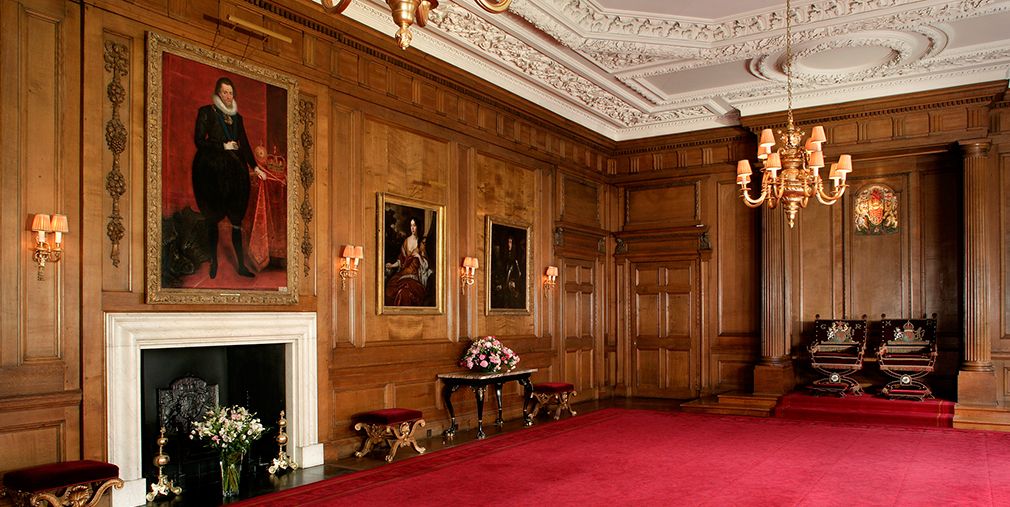

The Great Gallery is a fancy room, Investitures and banquets are held in the palace's Great Gallery, audiences are held in the Morning Drawing Room, lunch parties and receptions take place in the Throne Room, dinner parties are held in the State Dining Room, and annual garden parties are hosted in the gardens. When the King is in residence, the Scottish version of the Royal Standard of the United Kingdom is flown; at all other times, the Royal Banner of Scotland is displayed.
During the King's visits, the Royal Company of Archers form his ceremonial bodyguard and the High Constables of Holyroodhouse provide a guard of honor. The Ceremony of the Keys, in which the King is formally presented with the keys of Edinburgh by the Lord Provost of Edinburgh, is held on the Forecourt on his arrival. The wedding reception of Zara Phillips and Mike Tindall was held in the palace following their wedding at the Canongate Kirk in 2011.
In its role as the official residence of the monarch in Scotland, the Palace of Holyroodhouse has hosted a number of foreign visitors and dignitaries, including kings Olav V and Harald V of Norway, King Carl XVI Gustaf of Sweden, Mikhail Gorbachev, François Mitterrand, Helmut Kohl, Nelson Mandela, Vladimir Putin, Mary McAleese, Pope Benedict XVI, and Justin Trudeau. A meeting of the European Council was held at the palace in December 1992 during the British presidency of the council. Queen Elizabeth II gave a dinner at Holyroodhouse for the Commonwealth heads of government in October 1997 during the Commonwealth Heads of Government Meeting in Edinburgh.
The Royal Bedroom!
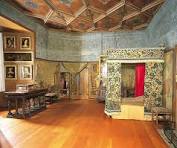
Walking around, Mike and Bone got a good read on how the Royal still use the Palace, but the most interesting rooms were Mary Queen of Scots rooms!
Mary Queen of Scots Pad!
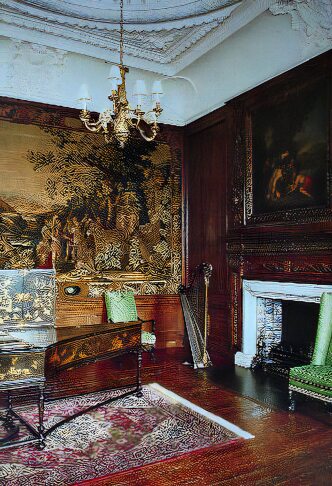
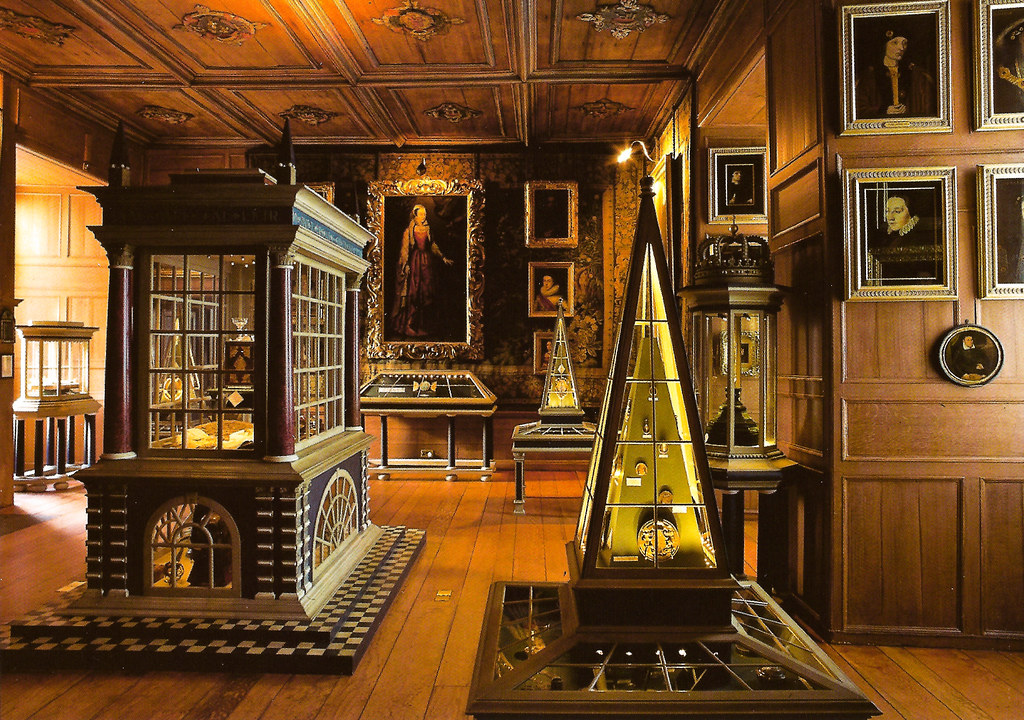
Mike and Bones tour ended in the royal apartments in James V's Tower were occupied by Mary, Queen of Scots from her return to Scotland in 1561 to her forced abdication in 1567.
Mary was a bit of a tomboy, she had archery butts erected in the south gardens to allow her to practice, and she hunted deer in Holyrood Park. Some of her French servants formed relationships with women in the Canongate. The Kirk authorities disapproved and made five of these unmarried women stand with bared heads at the cross near the palace for three hours in December 1564. The series of famous audiences Mary gave to John Knox, a local religious zealot, took place in her audience chamber at Holyroodhouse, and she married her second husband, Henry Stewart, Lord Darnley, in her private chapel in July 1565.
Being truly a drama queen, it was in the royal apartments that Mary witnessed the murder of David Rizzio, her private secretary, on 9 March 1566. Darnley and several nobles entered the queen's apartments via the private stair from Darnley's own apartments below. Bursting in on the queen, Rizzio and four other courtiers, who were at supper, they dragged Rizzio through the bedchamber and into the outer chamber, where he was stabbed to death, allegedly receiving fifty-seven dagger wounds, the blood stain can still be seen. After Mary's rooms, the Boys headed out to the oldest area of the Palace.
The Oldest Part, Holyroodhouse Abbey!
Mike and Bone walked out into the ruined Augustinian Holyrood Abbey that stands next to the Palace of Holyroodhouse, which was founded in 1128 at the order of King David I. The name derives either from a legendary vision of the cross witnessed by David I, or from a relic of the True Cross known as the Holy Rood or Black Rood, and which had belonged to Saint Margaret, David's mother.
As a royal foundation, and sited close to Edinburgh Castle, it became an important administrative center. A Papal legate was received here in 1177, while in 1189 a council of nobles met to discuss a ransom for the captive William the Lion. The Parliament of Scotland met at the abbey seven times between 1256 and 1410, and in 1328 the Treaty of Edinburgh–Northampton was signed by Robert the Bruce in the 'King's Chamber' at the abbey, indicating that it may already have been in use as a royal residence. In 1371, David II became the first of several kings to be buried at Holyrood Abbey, and James II was born, crowned, married, and buried there. James III and Margaret of Denmark were married at Holyrood in 1469.
The early royal residence was in the abbey guesthouse, and by the later 15th century the king occupied dedicated royal lodgings. Sadly, it hasn't been treated well. The English armies of the Earl of Hertford sacked Edinburgh and caused extensive damage to the palace and the abbey in 1544 and 1547 during the War of the Rough Wooing. Repairs were made by Mary of Guise, and in May 1559 she had a new altarpiece installed in the chapel royal,[14] featuring paintings from Flanders set in a frame made by a French carpenter Andrew Mansioun.
The altars were destroyed by a Protestant mob later in the same year, and after the Scottish Reformation was formalized, the abbey buildings were abandoned. The choir and transepts of the abbey church were pulled down in 1570. The nave was retained as the parish church of the Canongate. Now it is simply a husk of its former glory. With that Mike and Bone, headed back up the Royal Mile to top of the hill (an extinct volcano!), Edinburgh Castle!
Back UP the Royal Mile!
Mike and Bone's walk back up the Royal Mile showed just how steep the ancient cobblestoned streets were. They trudged up to a truly cool place, the heat of all of Scotland! Edinburgh Castle!
Mike and Bone, on Top of the Hill at Edinburgh Castle!
Castle Edinburgh stands on Castle Rock, which has been occupied by people since the Iron Age. The brooding, black crags of Castle Rock, rising above the western end of Princes St, are the very reason for Edinburgh's existence! This rocky hill was the most easily defended hilltop on the invasion route between England and central Scotland, a route followed by countless armies from the Roman legions of the 1st and 2nd centuries AD to the Jacobite troops of Bonnie Prince Charlie in 1745. Edinburgh Castle has played a pivotal role in Scottish history, both as a royal residence starting with King Malcolm Canmore III (r 1058–93) and Queen Margaret first made their home here in the 11th century ,as a military stronghold. The castle continued to be a royal residence until 1633. From the 15th century, the castle's residential role declined with the move to Holyroodhouse, and by the 17th century it was principally used as a military garrison. So when Mike and Bone went in through the Gate, they were truly walking in history!
Robert the Bruce and William Wallace, Guarding the Castle!
Above the gate is the Royal Standard of Scotland – a red lion rampant on a gold field, and the Scottish royal motto in Latin, "Nemo me impune lacessit" ("no one provokes me with impunity"). Each of the very cool flags, recalled another era of Scottish history.
Fortress Walls on Volcanic Rock
And boy what a turbulent history! Edinburgh Castle has played a prominent role in Scottish history, and has served variously as a royal residence, an arsenal, a treasury, a national archive, a mint, a prison, a military fortress, and the home of the Honors of Scotland – the Scottish regalia.
As one of the most important strongholds in the Kingdom of Scotland, the castle was involved in many historical conflicts from the Wars of Scottish Independence in the 14th century to the Jacobite rising of 1745.
Scottish research undertaken in 2014 identified 26 sieges in its 1,100-year history, giving it a claim to having been "the most besieged place in Great Britain and one of the most attacked in the world". Few of the present buildings pre-date the Lang Siege of 1573, when the medieval defenses were largely destroyed by artillery bombardment. The most notable exceptions are St Margaret's Chapel from the early 12th century, which is regarded as the oldest building in Edinburgh, the Royal Palace, and the early 16th-century Great Hall.
Iconic View of Edinburgh from Castle Rock!
Mike and Bone walked into the castle's Esplanade, which is a parade ground dating from 1820, with superb views south over the city towards the Pentland Hills. At its western end is the Entrance Gateway, dating from 1888 and flanked by statues of Robert the Bruce and William Wallace. Above the gate is the Royal Standard of Scotland – a red lion rampant on a gold field – and the Scottish royal motto in Latin, "Nemo me impune lacessit" ("no one provokes me with impunity"). Walking around they had the entire history
A Wee Bit of Scottish History!!
Mike and Bone walked into the castle's Esplanade, which is a parade ground dating from 1820, with superb views south over the city towards the Pentland Hills that Mike and Bone checked out above.
The Days of "Din Eidyn"!
Next, Mike and Bone were able to experience a Castle Edinburgh tradition! Inside the entrance a cobbled lane leads up beneath the 16th-century Portcullis Gate, topped by the 19th-century Argyle Tower, and past the cannon of the Argyle and Mills Mount Batteries. The battlements here have great views over the New Town to the Firth of Forth. At the far end of Mills Mount Battery is the One O'clock Gun, a gleaming WWII 25-pounder that fires an ear-splitting time signal at 1pm every day. Both Boys had their ears split real good, and they staggered off on the Esplanade to come across one of the hero's of World War I, or was he !?
Mike and Bone with the Butcher of the Somme,
Field Marshall Sir Douglas Haig
One of the more somber moments of the Boys World War One trip was the sauntering through the Somme. The Somme is where on 1 July 1916 when, in terms of casualties sustained, the British Army suffered the worst day in its history, with over 19,000 men killed based on Sir Douglas Haig's plan of attack. Walking through those trenches where all those men where killed was a sobering experience for Mike and Bone. Some call him a hero, some a villain, here, at Castle Edinburgh, the Scottish Haig is honored as a hometown hero! Next, the Boys walked up to the Ramparts to check out the amazing view.
A Sweeping Panorama of Edinburgh from Castle Edinburgh!
It was easy to see how the early Scots were so keen on controlling this spot. They could see enemy (usually English) armies marching for miles and miles away. A truly cool view! Mike and Bone then headed into the main part of the Castle.
Palooka's in the Palace!
Mike and Bone stood in line to go into the Royal Palace, built during the 15th and 16th centuries, it houses a series of historical tableaux leading to the highlight of the castle: a strongroom housing the Honors of Scotland (the Scottish crown jewels), which are among the oldest surviving crown jewels in Europe. The Honors were lost for a time, locked away in a chest following the Act of Union in 1707, the crown (made in 1540 from the gold of Robert the Bruce's 14th-century coronet), sword and sceptre lay forgotten until they were unearthed at the instigation of novelist Sir Walter Scott in 1818. Also on display here is the Stone of Destiny. The Stone of Destiny is pretty cool, it is an ancient symbol of Scottish monarchy and kingdom. A king-making stone, it was used in the inauguration of Scottish monarchs at Scone, 3 miles upriver of Perth on the River Tay. Its first documented use was in 1249 for the inauguration of the boy-king, Alexander III.
Among the neighboring Royal Apartments is the bedchamber where Mary, Queen of Scots, gave birth to her son James VI, who was to unite the crowns of Scotland and England in 1603.
Palace Chambers
Among the neighboring Royal Apartments is the bedchamber where Mary, Queen of Scots, gave birth to her son James VI, who was to unite the crowns of Scotland and England in 1603. After the Palace, Mike and Bone went to a dark part of the Castle!
David's Joint
Mike and Bone waked to one of the older parts of the Castle, David's Tower. Scotland’s King David II was responsible for building the once mighty David’s Tower. The tower was the heart of the castle in the late 1300s and originally stood over 100ft high.
At the time it was the royal residence at Edinburgh Castle for almost 100 years, where kings could welcome foreign diplomats in grand surroundings. David II had spent years in England and France, living in fine stone towers. On his return he was intent on creating his own statement in stone as a reflection of his power and kingship.
The structure took nine years to build and wasn’t complete when David died in 1371. By the early 1500s, David’s Tower had been eclipsed as a royal residence by the Royal Palace. But in troubled times, it was still an important defensive structure.
Part of the basement and principal floors survive, and these atmospheric ruins can be accessed today by a stair at the back of the Half-Moon Battery which Mike and Bone went down to the cellar to a grisly story.
No Bull!?!
Mike and Bone checked out what is now the cellar remnants of David's Tower, which back in the was a banquet room that had a very gory dinner, or "black" dinner. Back in the day the Scots played politics hard and often lost their heads, literally! In 1440, the 16-year-old William Douglas, 6th Earl of Douglas, and his younger brother were invited to dine with the ten-year-old King James II of Scotland. Later called the Black Dinner, the occasion was organized by the Lord Chancellor, Sir William Crichton, and James Douglas, 7th Earl of Douglas who inherited the young earl's wealth and titles.
While they ate, a black bull's head, a symbol of death, was brought in and placed before the Earl. Over the protests of the young King James II, the two brothers were then dragged out to Castle Hill, given a mock trial and beheaded. Clan Douglas then laid siege to Edinburgh Castle. Perceiving the danger, Crichton surrendered the castle to the king and was rewarded with the title Lord Crichton. It is still unclear exactly who else was ultimately responsible, though it is thought Livingston and Buchan were likely candidates. Ironically, it was James Douglas and his son who profited. With that grisly story, Mike and Bone climbed back up the stairs, to moved on to a happier parts of the Castle!
The Oldest Building in Castle Edinburgh - St. Margaret's Chapel
Next the Boys check out St Margaret's Chapel, which is in fact the oldest surviving building in Edinburgh! A fine example of Romanesque architecture, it was constructed in the 12th century. Built for an English princess from the House of Wessex, Margaret (c. 1045 – 16 November 1093), the sister of Edgar Ætheling. Margaret and her family fled to Scotland following the Norman conquest of England of 1066.
Around 1070 Margaret married Malcolm III of Scotland. She was a pious woman, and among many charitable works she established a ferry across the Firth of Forth for pilgrims travelling to Dunfermline Abbey. According to the Life of Saint Margaret, attributed to Turgot of Durham, she died at Edinburgh Castle in 1093, just days after receiving the news of her husband's death in battle. In 1250 she was canonized by Pope Innocent IV. It was built during the reign of David I, her fourth son, who ruled from 1124–1153. The chapel formed part of a larger building, located to the north, which contained the castle's royal lodgings.
The Chapel has had an interesting history, on the night of 14 March 1314 the castle was captured by Robert the Bruce. He destroyed all the buildings in the castle, except for the little chapel. On his death bed in 1329, Bruce spoke of the story of Queen Margaret and issued orders for the chapel's repair, with some forty pounds Scots being put aside for that purpose. For many years afterwards the building was known as the "Royal Chapel in the Castle". There is a fairly frequent record of services held in the chapel, though another and larger chapel was also in use within the castle. Walking around the little Chapel was cool and quick. Next it was time to check out the Big Guns!!
The Monster Mons Megs
Boys like to play soldier when they are growing up, play with the monster Mons Meg Cannon would be a ton of fun! In fact kids crawl in it all the time now! Mons Meg was built in 1449 on the orders of Philip the Good, Duke of Burgundy and sent by him as a gift to James II, King of Scots, in 1454. It has a barrel diameter of 20 inches, making it one of the largest cannons in the world by caliber.
Mons Meg was employed in sieges until the middle of the 16th century, after which has only been fired for ceremonial occasions.
Farewell the Castle!
After checking it out Mons Meg, Mike and Bone had thoroughly checked out the Castle and were all ramped with military fervor, so ran down the Royal Mile to take the hill!!! Literally!!!!
Taking on Arthur's Seat!
At the base of Holyroodhouse is an ancient extinct volcano which is the main peak in Edinburgh. It is sometimes said that its name is derived from legends pertaining to King Arthur, such as the reference in Gododdin.
Today, it is a part of Holyroodhouse Park and provides a path to the top for hikers to check out the awesome view of Edinburgh and the Firth of Forth bay!
Bone Took Seat on Arthur's Seat!
With gusto, Mike and Bone strode up the path with Bone inevitably and quickly falling behind! Bone, however had climbed it before and decides the faster way was to abandon the path and walk straight up and pass Mike to the top!
Unfortunately, the longest distance between two points is a straight line, especially in a slippery, straight up walk up the hill between the paths. Bone fumbled, stumbled, and bumbled, and not only did not pass Mike, but never got up with his stupid idea! Chastened, he abandoned the trip as Mike walked his way down, with his butt good and muddy!
After Bone's shenanigans, it was time for lunch and a beer!!
Lunching at Worlds End
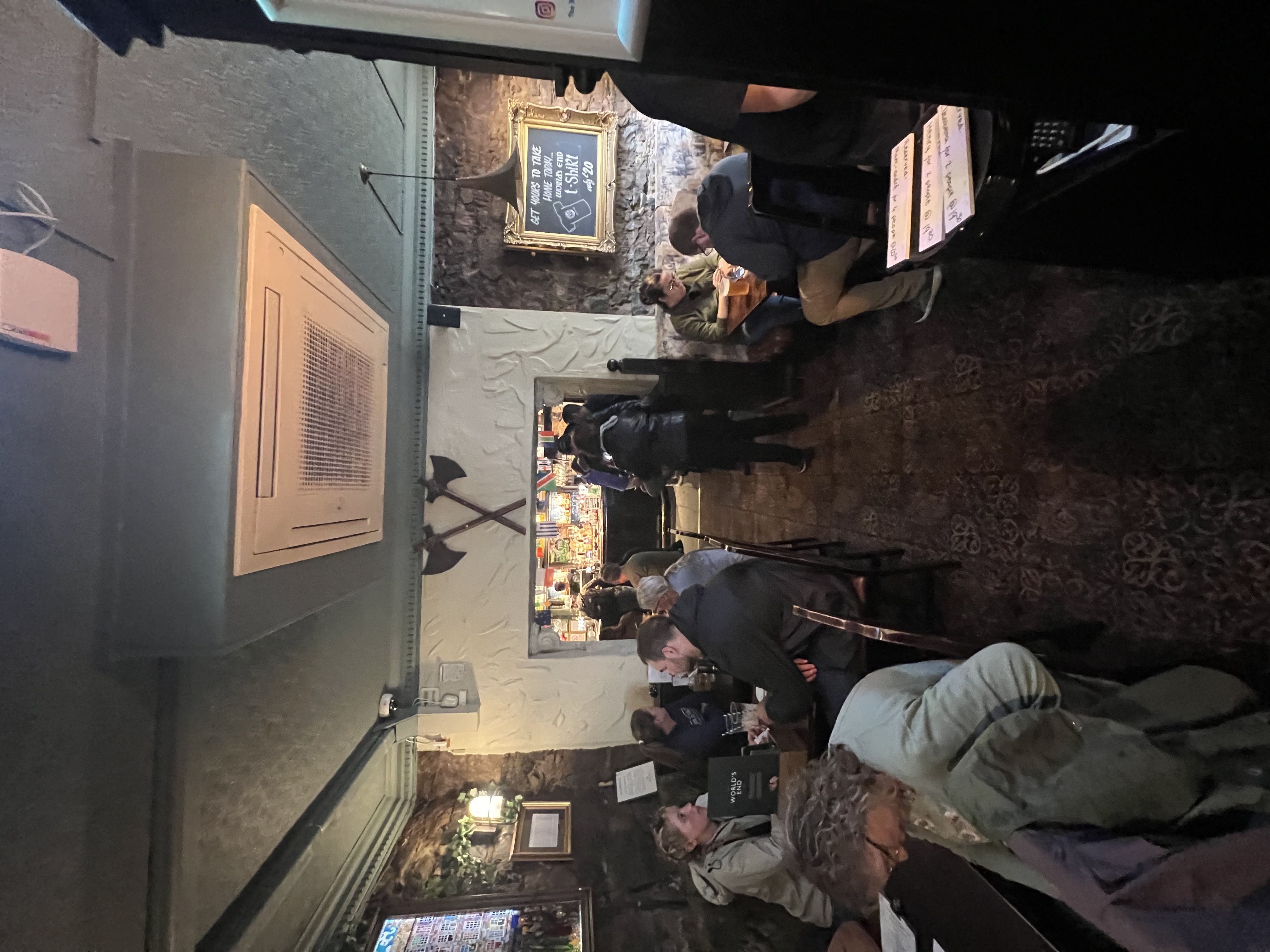

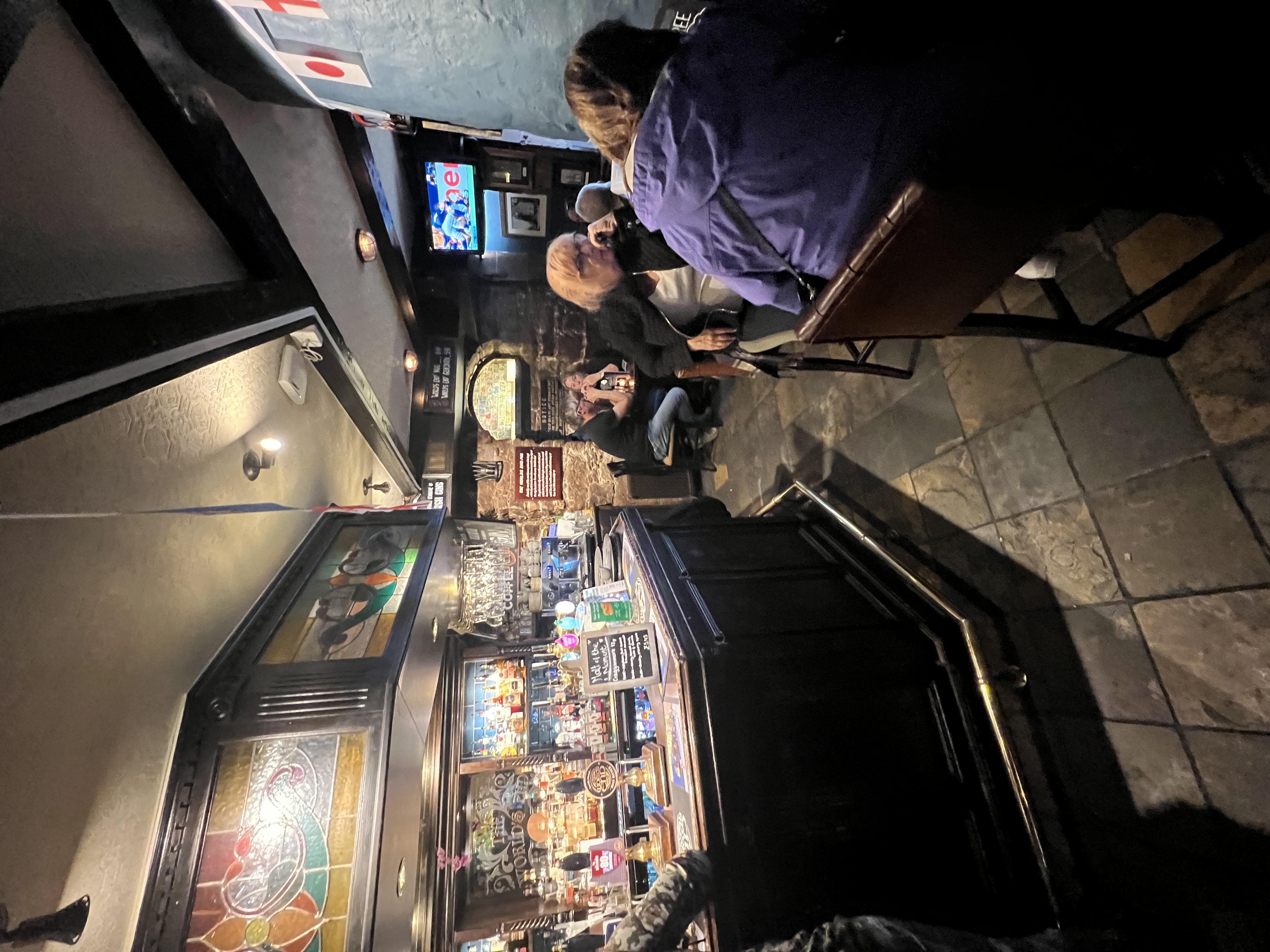
The Boys hit the first Pub by Arthur's Seat, which happened to be Lands End! Sitting down, Mike and Bone learned about the level of service in a "tip-free" Euro-zone. The Boys "server" was irritated that they expected to be served at the end of his shift. So the Mile and Bone placed there order, he submitted the order, then left the building! Eventually, they got their cold sheppard pies and warm beers, but with great amusement! By Then it was getting late in the day, and it was high time to sample some of the iconic pubs on the Royal Mile, like the Mitre!
Monkeying Around in the Mitre
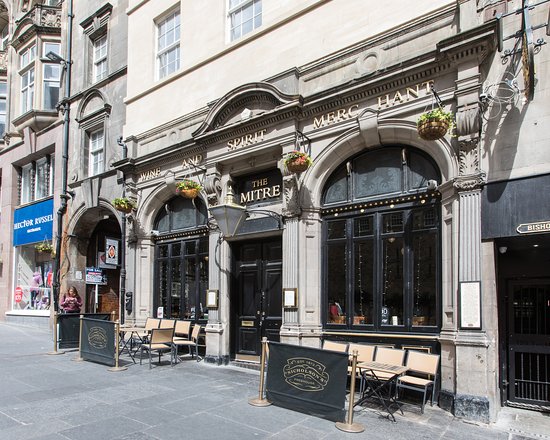
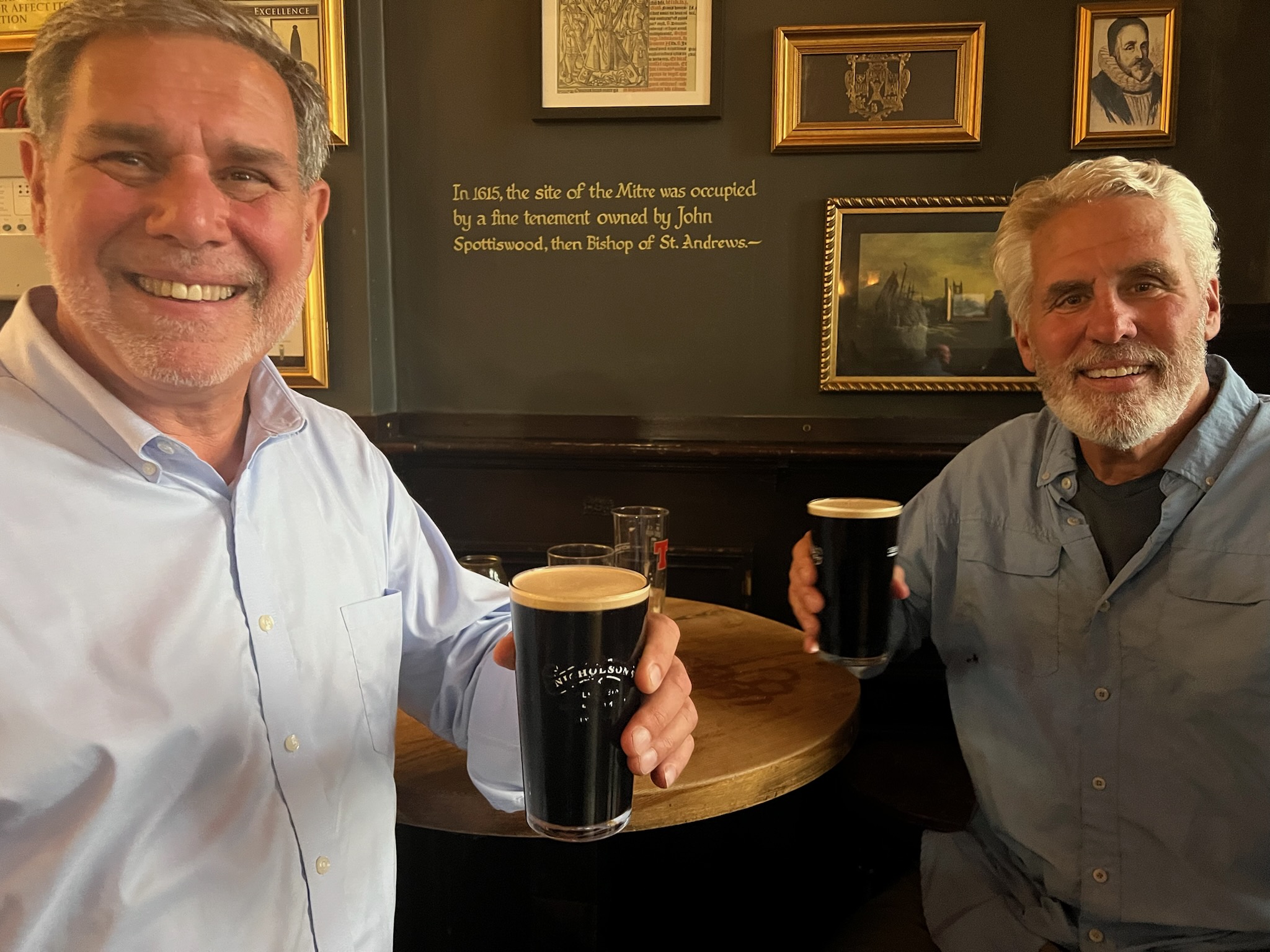
Mike and Bone went into the Mitre which with everything else in town is a historic site. In 1615, the site of the Mitre tavern was occupied by a fine tenement that was owned by John Spottiswood, then Bishop of St Andrews. The tenement burned down in 1814 and was replaced by The Mitre Bar, a nod to the bishop's headgear. Legend has it that the bishop's throne is buried under what is now the bar area, hence its name. The Mitre had some might fine Guinness on tap that required Mike and Bone to down two before their thirst was quenched long enough to move on to one of Bone’s ABSOLUTELY favorite pubs of all time!
Having a Jolly Time at the Jolly Judge!!!
What makes a great pub, its the vibe! The Jolly Judge is truly unique and special. It shouldn't be this great because it's in the middle of some of the heaviest tourist traffic in town. But it's through a little "close" and only for the adventurous, it is truly more of a local's bar, like Cheers. Not necessarily divey, but it's a bit of a hole in the wall. You walk down the stairs into a tiny little pub full of life and good vibes. Friendly barkeepers and good conversation and on a busy day the crowd flows out into the courtyard. Bone discovered it over 10 years ago and both he and Mike loved the local Scottish cask conditioned McEwan 18% and the Boys drank a few of those, along with a wee dram of the liquid gold better known as 18 year old Balvenie Scotch Whisky! The Boys reflected on the day while the ale and whisky did its work and turned the whole evening into a lovely party! Eventually the Boys had to leave and start back to the Hotel, however the Boys it turned out had a little more "bull" to dish out!
A Little More Bull in the Black Bull!
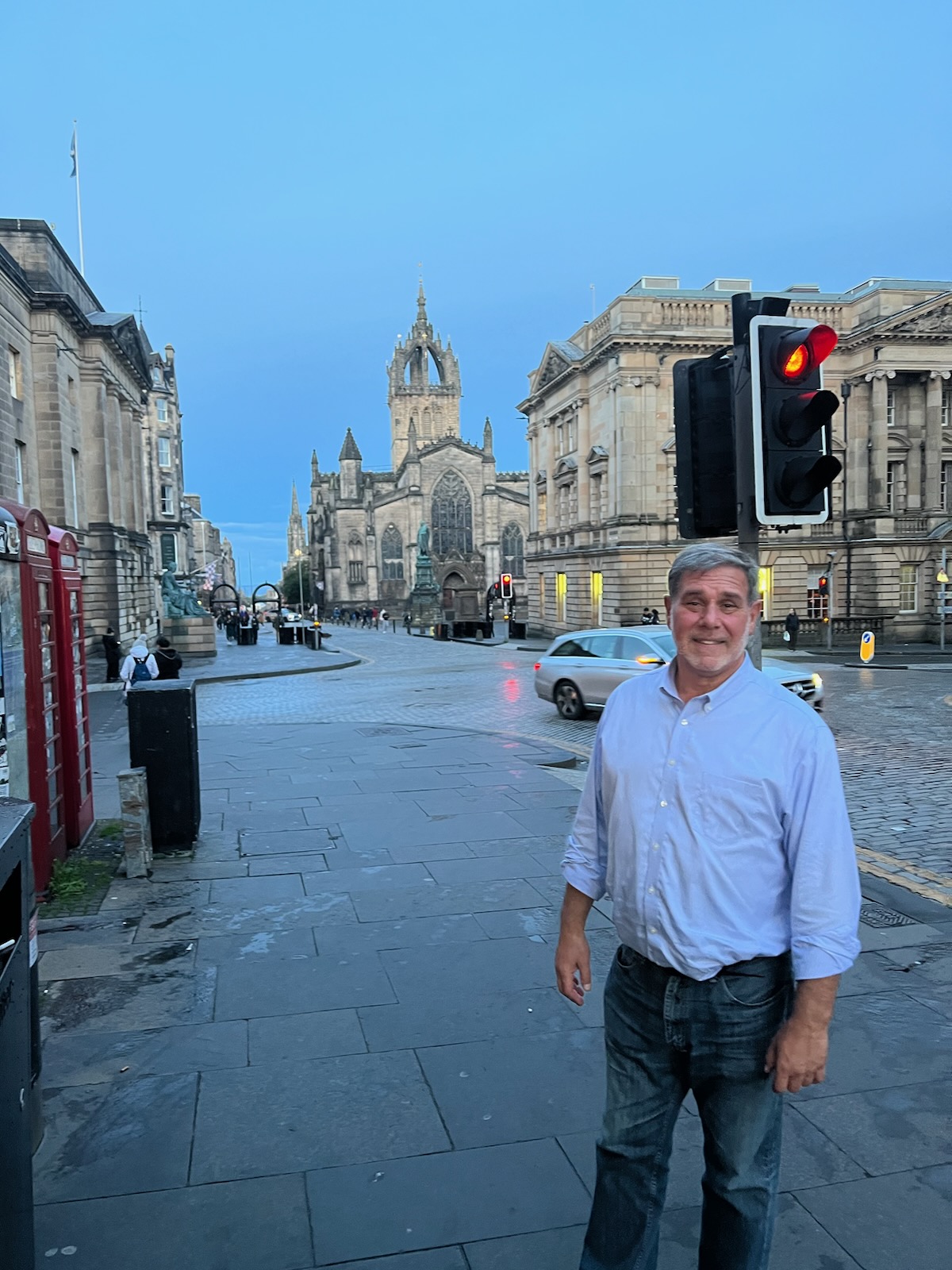
As the Boys got close to the Hotel, they passed a very local bar called the Black Bull, where a bunch of locals were carousing outside the door, looking like fun, Mike and Bone decided for a nightcap and joined in! Especially with an unemployed local that was celebrating his birthday but could barely speak his name! Several Guinnesses were served to Mike, Bone, and their new friend, until the wee hours when the Boys finally called it a night and an capstone to an awesome trip!
Trip, Postscript!
Next Morning Bone caught an Uber at 4:30 in the morning to catch his 6:00 flight from Edinburgh to London, to catch his 10:00 AM flight to Detroit on Virgin Air! Mike got a car and drove to Glasgow, where he met Sherrie the next day and they toured the northern part of Scotland including the Orkney Islands for the next two weeks. From Sarajevo to Scotland, from hot to cold, from bone dry and soaking rains, Mike and Bone Romed the Northern Border of the Roman Empire!